Mínimos: Dual Core, 2 GB RAM, Windows 7 o 8.1, DirectX11, tarjeta gráfica con 256 MB RAM, unidad lectora de DVD-ROM, Windows Media Player 9 y acceso a Internet para la activación del producto. Recomendados: PC Intel i5 (Quadcore), 4 GB RAM, Windows 10, DirectX10, tarjeta gráfica con 512 MB RAM o más, tarjeta de sonido al 100% compatible con DirectX11, Windows Media Player 11, unidad lectora de DVD-ROM y acceso a Internet para la activación del producto.
Las recomendaciones del editor
- El Campeón del Mundo superado: Levon Aronian analiza su victoria sobre Carlsen en el Norway Chess.
- Sacrificio de calidad de alto nivel: el ganador del 2º torneo del Grand Prix de la FIDE comenta su victoria más espectacular en Moscú: Ding Liren-Vachier Lagrave.
- “Jugada a jugada” con Simon Williams: profundice en su conocimiento de la Najdorf jugada a jugada con la partida de alto nivel Ponomariov-Wojtaszek (vídeo).
- Atrapa la dama con clase: disfrute del segundo golpe de Aronian en Stavanger en el videoanálisis de Daniel King.
- “Mate de Reti”: en el curso de entrenamiento de la FIDE de Efstratios Grivas aprenda una idea poco frecuente, pero de alta eficacia táctica.
- “Sin camino claro para igualar”: el GM Postny reúne las tendencias en el gambito de Dama Aceptado y llega a una conclusión crítica.
- ¿Qué hacer contra la variante del Cambio de la Ruy López? Daniel King le presenta la situación actual de la teoría (vídeo).
- Una jugada defensiva con diabólicas profundidades ocultas: deje que Rainer Knaak le muestre como plantear la “celada de Leonhardt” en la defensa Philidor (vídeo).
- Buena en la práctica: Nadezhda Kosintseva le dota con el arma universal 4.e5 Cfd7 5.Cce2 contra la variante Steinitz de la Francesa.
- El golpe de Hammer 14...Txf3: Adhiban analiza esa brillantez contra Akobian en el mundial por equipos.
Recommendations for your repertoire Papp: Benkö Gambit A58(Recommendation for Black)
1.d4 Nf6 2.c4 g6 3.Nf3 Bg7 4.g3 c5 5.d5 b5 6.cxb5 a6 7.bxa6 d6 8.Nc3 0-0 9.Bg2 Nbd7 10.0-0 Nb6 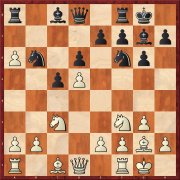
| | The move order is quite deliberately not that of the original Volga Gambit. Because Petra Papp intends her repertoire suggestion for Black specifically as a weapon against the King’s Indian or the Grünfeld Defence with g3. It is very important for Black to delay the recapture on a6. |
Moskalenko: Dutch Defence A80 (Recommendation for Black)
1.d4 f5 2.Nc3 Nf6 3.Bg5 d5 4.e3 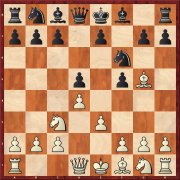
| | Many players have realised that the capture 4.Bxf6 does not bring the hoped for results, see also the article in CBM 177. Therefore Viktor Moskalenko has also dealt with the solid alternative 4.e3. White wants to play Nf3, Bd3, Ne2 and then c4, but that is somewhat slow. |
Kosintseva: French Defence C11(Recommendation for White)
1.e4 e6 2.d4 d5 3.Nc3Nf6 4.e5 Nfd7 5.Nce2 c5 6.c3 Nc6 7.Nf3 
| | As Nadezhda Kosintseva demonstrates in her contribution, with best play Black should certainly be able to equalise against 5.Nce2. However, there is a great dearth of knowledge concerning the best plan for Black and a well prepared player with White can therefore count on having some chances. |
Kritz: French Defence C15(Recommendation for White)
1.e4 e6 2.d4 d5 3.Nc3Bb4 4.a3 Bxc3+ 5.bxc3 dxe4 6.Qg4Nf6 7.Qxg7Rg8 8.Qh6 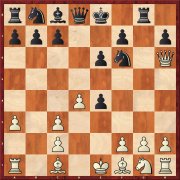
| | The move 4.a3 has no strong advocates at the moment. But Leonid Kritz shows that things are not quite so clear-cut and that in the position in the diagram Black actually has only one good move. But that knowledge does not appear to be very widespread. |
Kuzmin: Ruy Lopez C83(Recommendation for Black)
1.e4 e5 2.Nf3Nc6 3.Bb5 a6 4.Ba4Nf6 5.0-0 Nxe4 6.d4 b5 7.Bb3 d5 8.dxe5 Be6 9.Nbd2Nc5 10.c3 Be7 11.Bc2 d4 12.Nb3 d3 
| | In games amongst the world elite, whenever the Open Ruy Lopez is played you can almost certainly count on the position in the diagram appearing. Alexey Kuzmin has investigated it and come to the conclusion that Black has good chances of equalising but that there is a great amount he needs to know. |
Sumets: Semi-Slav D46(Recommendation for White)
1.d4 d5 2.c4 c6 3.Nc3Nf6 4.e3 e6 5.Nf3Nbd7 6.Qc2Bd6 7.Bd3 0-0 8.0-0 e5 9.cxd5 cxd5 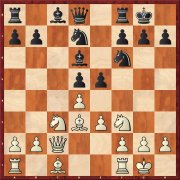
| | The variation with 8...e5 is a very good drawing weapon. But you need to be prepared to defend a minimally worse endgame, which according to Andrey Sumets does not represent the correct strategy for everyone. White should be prepared to react flexibly. |
Marin: Grünfeld Defence D93(Recommendation for Black)
1.d4 Nf6 2.c4 g6 3.Nc3 d5 4.Bf4Bg7 5.e3/Nf3 0-0 6.Nf3/e3 c6 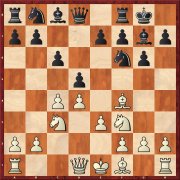
| | Here White apparently has the favourable version of a Schlechter Defence, because the bishop has already been developed to f4. But Mihail Marin points out in his article that the bishop is also exposed there and that Black thus has some additional possibilities. |
Ris: Grünfeld Defence D96(Recommendation for Black)
1.d4 Nf6 2.c4 g6 3.Nc3 d5 4.Nf3Bg7 5.Qb3 dxc4 6.Qxc4Be6 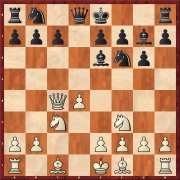
| | It may be mostly White who wants to deviate from the deeply analysed variations in the Grünfeld Defence, but for Black too the necessity for extensive theoretical knowledge is of course just as much a problem. So Robert Ris suggest the as yet rarely played 6...Be6. |
Stohl: Nimzoindian E21(Recommendation for Black)
1.d4 Nf6 2.c4 e6 3.Nc3Bb4 4.Nf3 0-0 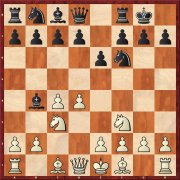
| | Igor Stohl’s article deals principally with 5.Bg5 (5.e3 and 5.Qc2 would tend to transpose to other main systems). Then 5...c5 is a move which fits in well with the opening and according to our Slovakian author gives a satisfactory game. |
Krasenkow: King's Indian E94(Recommendation for White)
1.d4 Nf6 2.c4 g6 3.Nc3Bg7 4.e4 d6 5.Nf3 0-0 6.Be2 e5 7.0-0 Na6 8.Re1 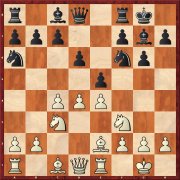
| | Michal Krasenkow examines above all the two most important replies for Black, both 8...c6 and 8...Qe8. After them he considers White to have an advantage since “It is not easy for Black conjure up satisfactory counterplay”. |
|











